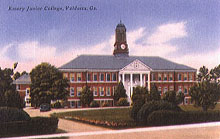Enigma
|
Postcard
from
the Past

|
THE
POSTCARD, printed
in the muted hues of vintage National Geographic magazines,
is pristine, but the place it pictures passed into history nearly
fifty years ago.
Founded in 1928, Emory
Junior College at Valdosta foundered in the 1950s, due largely
to declining postwar enrollment and competition from the state
university system.
Plans for a Valdosta
campus began in the mid-1920s, when the town's civic leaders offered
Emory trustees forty-three acres of land; a distinctive, white-columned
building that housed classrooms and administrative offices; and
a $200,000 endowment. The campus was located 225 miles south of
Atlanta, just twenty minutes from the Florida border.
On Sept. 26, 1928,
the school welcomed its first class of fifty freshmen. Tuition
was $50 per quarter. With no existing dorms, students sought housing
at the privately owned College Inn and in family homes throughout
the town and the nearby campus of Georgia State Women's College.
Sixteen students made
up the first graduating class of the all-male school in 1930.
The campus' first dormitory was completed the next year, and in
1936, Emory funded the construction of Centennial Swimming Pool
to commemorate the University's one hundredth year.
The onset of World
War II caused the already modest enrollment (an average of sixty-one
students) to plummet, as scholars became soldiers. A delegation
of Emory administrators traveled to Valdosta to suggest that the
school close. When the town's leaders objected, a compromise was
reached, and students, faculty, and staff moved to Atlanta for
the duration of the war.
The school reopened
in 1946 with a record enrollment of 247, buoyed by an infusion
of students on the G.I. Bill and an aggressive recruiting drive.
Additional classrooms and a dorm comprised of Army surplus buildings
were brought from nearby Moody Air Force Base. In a nod to the
nearby Okefenokee, the dorm quickly become known as Swamp Hall,
due to its Spartan accommodations.
"They sold me,"
says Lawrence R. Morgan '56D, a Naples, Florida, dentist who transferred
from the University of Florida and attended the Valdosta campus
from 1950 to 1952. "I found out I could get into the junior
college system and then go on to Emory. I thought the University
of Florida was too big then, and knowing I could get into Emory's
dental school, I decided to go."
Morgan became one
of the last graduates of the school. After the G.I. Bill class
that preceded him, enrollment again fell to less than one hundred.
The Valdosta campus' fate was sealed when Georgia State Women's
College, renamed Valdosta State College, admitted men in 1950.
By 1953, just sixty-five students remained.
"The new Valdosta
school was state supported and had a cheaper tuition," remembers
Dean of Alumni Judson C. "Jake" Ward Jr. '33C-'36G,
dean of Emory
College from 1948 to 1957. The Valdosta site also did not
enjoy the same historical roots, affiliation with the Methodist
church, and local patrons that helped fuel the success of Emory's
other sister campus, Oxford
College.
Emory's South Georgia
Division closed in 1953, and in a final ironic twist, its facilities
were given to its chief competitor, the University
System of Georgia, and became part of Valdosta State College,
now Valdosta
State University.
But for Morgan, attending
the Valdosta campus remains a big part of his Emory experience.
"We wore suits, and it was 'Yes sir' and 'No sir,' and everyone
was treated like a gentleman. Valdosta had an academic environment
I have not found duplicated anywhere."--G.F.
|
